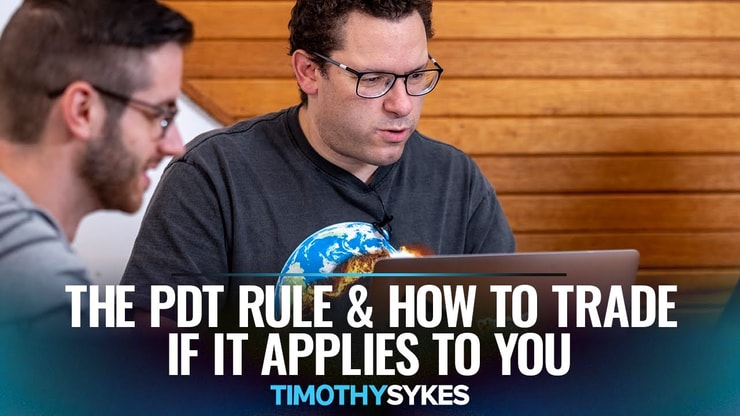Day trading on margin is a risky trading strategy.
Most day traders lose, and trading on margin multiplies your risk.
Your losses can mount and blow up your account. That’s why my number one rule is to cut losses quickly.
EXPERIENCE pays, newbies blow up, it's always the same & yet they don't realize it until it's too late, nor do those who follow the newbies into risky/half-assed strategies by only thinking about the potential upside not the downside risks they take far too often #knowledgeiskey
— Timothy Sykes (@timothysykes) April 26, 2020
There’s no such thing as a perfect strategy. Some trades you’ll win, some you’ll lose. Self-sufficient day traders understand that losing is part of the game.
I teach my students to integrate risk into their trading plans.
That gets harder to do when you’re day trading on margin. So let’s break it down!
Table of Contents
- 1 What Is Margin Trading?
- 2 Day Trading Margin: Primary Uses
- 3 Day Trading on Margin: Advantages and Disadvantages
- 4 Day Trading on Margin: Requirements
- 5 Day Trading Margin Calculator
- 6 Non-Pattern vs. Pattern Day Traders
- 7 Margin Calls
- 8 Day Trading on Margin: Frequently Asked Questions
- 9 Can You Day Trade With Margin?
- 10 What Is Margin Trading?
- 11 How Much Does the Average Day Trader Make?
- 12 Day Trading on Margin: The Bottom Line
What Is Margin Trading?
Margin trading is when you borrow funds from your broker to take a bigger position.
This isn’t free money. Your broker won’t forget the loan.
And there are a lot of rules around margin trading…
But once you understand the rules, day trading on margin can be an effective strategy. But educate yourself on every aspect of it first.
How Does Margin Trading Work?
Margin trading differs from broker to broker.
The Fed sets basic margin rules for all brokers. Some brokers then place additional restrictions on margin trades.
Those rules and restrictions determine how much you can borrow on margin and how much needs to be in your account.
Fidelity’s day trading rules may be different than Robinhood’s … The shares they allow you to short could be too!
Remember, you need a margin account to short stocks. And the stocks you can borrow differ from broker to broker.
So it’s important to find the right broker for your trading strategy. That’s a big step toward becoming a self-sufficient trader. Need tips? Check out my guide to online brokers here.
Day Trading Margin: Primary Uses

Day trading on margin is like any other form of margin trading. You’re borrowing money to make the trade.
There’s potential for greater profits … and losses.
Day trading on margin can be a powerful strategy, but not if you make random trades. You need a strategy.
I created my Trading Challenge to educate traders on the risks and rewards of day trading. I want to be the teacher I didn’t have when I began trading.
Every day, promoters and Twitter celebrities talk about how easy it is to make money trading. Sorry, but it isn’t.
Trading can give you a great life … But not without hard work.
You need to learn to build watchlists and screen for the right stocks. And you must know how to put together a good trading plan…
Then you have to track all your trades in a trading journal or on a platform like Profit.ly. Then you can go back and review trades to see the patterns that work best for you.
My Trading Challenge can help with each of those steps. Plus, you get access to 7,000 video lessons to dive deeper into different aspects of trading … and a ton of webinars that I host with other top traders.
There’s also a no-nonsense chat room where we look at patterns and break down trading plans.
Education is key to becoming a self-sufficient trader. Even my millionaire students put in the time and effort. They didn’t become profitable overnight!*
They went through the same education I’m offering you.
If you’re willing to work hard and stay disciplined, apply to my Trading Challenge here.
Day Trading on Margin: Advantages and Disadvantages

There are many rules to day trading on margin. And opening a margin account can be tricky for new traders.
But there’s also upside potential. So it’s important to understand the pros and cons of this strategy. Let’s look at both…
Advantages
- Magnified profits. This is the most common reason for day trading on margin. Margin trading usually gives you greater leverage than a cash account, which means accounts can grow much faster — in theory.
- Expanded price range. I trade penny stocks — but that’s only a small portion of the overall market. Greater buying power makes a big difference for higher-priced stocks.
- No settlement period. This is a big advantage margin trading has over cash. Cash account trades have a settlement period before you can trade with the proceeds. This is typically T+2 — the date of the trade plus two days. Margin trading has no settlement period, so you can use the money from a margin trade as soon as it hits your account.
More Breaking News
- Ambev S.A.: Is the Dip a Golden Opportunity or a Red Flag?
- GTBP Stock Buzz: Exploring the Latest Dynamics in Cancer Treatment Innovation
- BigBear.ai Has Secured the GSA OASIS+ Contract! What Does This Mean for Investors?
Disadvantages
- Heightened risk. Yep, this is the big one. Leverage helps traders profit more quickly … but it also multiplies the risk.
- Margin calls. Traders who don’t know when to cut their losses can have big problems with their margin requirements. Your broker can issue a margin call at any time. That means you must immediately deposit more money into your margin account. If you don’t, your broker can close out your position.
- A more complicated trading plan. Day traders don’t have to worry about margin rates. But if you hold a position overnight, you need to work it into your trading plan. And if you short stocks, things can get more complicated. We talked about why earlier … Does your broker have shares of the stock to short? What are the borrow fees? Consider every aspect of the trade in your bottom line.
- Fewer options. There are non-marginable securities, hard-to-borrow stocks, and high borrow rates. And some brokers are better than others at locating OTC stocks for shorting. There’s a lot to juggle when you margin trade. You’ll learn this through experience — and with a good trading community!
- The pattern day trader rule. Above everything lurks the threat of being labeled a ‘pattern day trader.’ Restrictions come with this status — including a 90-day day trading ban.
Day Trading on Margin: Requirements

If you’ve read up to here, you know by now that day trading on margin has a different set of requirements.
Most U.S. brokers have a minimum requirement of $2,000 in equity to open a margin account. Check with your broker for specifics.
Some overseas brokers have equity requirements as low as $500 … but there’s also greater risk.
The Fed’s Regulation T normally requires traders have at least 50% of a margin trade’s initial cost…
But day trading on margin is different. Many brokers quadruple your day trading buying power.
Then there’s the maintenance requirement. Your account equity can’t dip below 25% of the current market value of your margined position. Otherwise, you might get hit with a margin call.
Margin rate and borrow fees probably won’t hit you as hard if you’re a short-term trader. But you must pay attention to the pattern day trader rule…
Pattern Day Traders
The pattern day trader (PDT) rule should be one of your biggest considerations…
Day trading rules are different for traders with over $25K in their margin accounts. If you have less than that, you’re restricted to three or fewer day trades a week!
What happens if you trade more than that? You could get slapped with pattern day trader status, which means you’ll have day trading restrictions.
Want to know how to remove pattern day trader status? Just wait 90 days before making your next day trade. Nope, there’s no other way around it.
Pattern Day Trading on Margin
The PDT rule only applies to margin trading.
If you’re day trading from a cash account, you can trade as long as your settled cash holds up.
Buying Power
The buying power for a margined trade is usually equal to twice the equity in your account at most…
Day Trade Buying Power
Believe it or not, there are some advantages to PDT status.
Some brokers can increase PDTs’ day trading buying power up to four times their equity. That’s a lot … But it also means more risk and more restrictions.
For example, if you don’t cut your losses quickly, your broker is more likely to make a margin call. So if your account shows negative day trading buying power, pay attention.
Also, some securities can’t be purchased with day trading buying power…
You need to consider all of those things in your trading plan.
Day Trading Minimum Equity Calls
A margin account with PDT status can’t fall below $25,000. If it does, you may be hit with an equity maintenance (EM) call.
An EM call limits your flexibility. You’ll need to deposit the difference before you can day trade again.
Day Trade Buying Power Call
Want to give yourself a headache? Exceed your day trading buying power and see what happens.
Your trades will be restricted up to two times your equity for five business days. After five days, you’ll need to meet the call amount.
What happens if you can’t? Nothing good…
Regulation T Restricted Accounts
Traders who can’t meet the day trading call are restricted to cash trades for 90 days or until the call is met.
And if you get a second day trading buying power call in 90 days, you’ll be subject to restrictions no matter when you meet the call.
Prohibition on Liquidating to Meet a Regulation T Call
Day trading calls require cash, paid-in-full securities, or non-marginable securities. Checks have a four-day hold, and electronic transfers have a three-day hold.
But hey, mistakes happen. So what do you do if you only have stock to sell to meet the call?
First of all, it’s not ideal. You need to multiply the call amount by four to arrive at the amount of stock you need to sell…
That sale will also be considered a day trade liquidation. Log three of these liquidations within a 12-month period, and you risk sanctions.
Day Trading Margin Calculator
Since brokers have different rules, there aren’t any perfect calculators out there. But this is still important.
Brokers have their fees and conditions listed somewhere … Find them or give them a call.
You must know the rules before you start day trading on margin. It’s just too easy to break them if you don’t pay attention.
Non-Pattern vs. Pattern Day Traders

Have I scared you enough? Good. I want you to know the PDT rule inside out.
That’s why I have a lot of resources dealing with PDT. Here’s some of them — Check them out:
- What Is The Pattern Day Trader (PDT) Rule in Stock Market Trading?
- Get Over the PDT Rule Now: Learn the Patterns I Use!
- The Hidden Benefits of the Pattern Day Trader Rule
If you took the time to check out the links above, you know the PDT rule isn’t evil. But you have to understand it.
To me, making fewer trades is a good thing. The PDT rule encourages traders to plan and punishes those who act on impulse.
And that’s exactly what I teach my students — you must have a plan before you start trading.
Margin Calls
Margin calls are the other boogeyman out there…
Here’s the good news. If you trade conservatively, you likely won’t get hit with a margin call.
I teach my students to act like retired traders. Only trade the best setups. Never risk more than you can afford to lose.
Margin calls happen when traders don’t pay attention to the risk. If you cut losses quickly, you should never be in this position.
Day Trading on Margin: Frequently Asked Questions
Still have questions? Let’s review.
Can You Day Trade With Margin?
A better question: Can you day trade with a cash account? Day trading on margin fits FINRA’s definition of pattern day trading. Cash accounts don’t have the same restrictions.
What Is Margin Trading?
Margin trading uses borrowed cash to increase the size of a position. It’s a good way for a small account to grow fast … but you must know the risks and rules first!
How Much Does the Average Day Trader Make?
The average trader doesn’t make money at all. Most traders lose money. That’s why I emphasize education. I want you to avoid the trap of being average.
Day Trading on Margin: The Bottom Line
Day trading on margin is one of the best ways to exponentially grow your account…
It’s also one of the best ways to blow up your account.
The difference here is understanding risk. There are lots of risks to understand — you have to know them all. A good education is what will help you avoid blowing up your account.
If you’ve already started day trading on margin, it’s time to learn some strategy. Apply for my Trading Challenge if you think you’re ready. I want to share the benefits of trading with as many students as I can.
Did this article clear up your questions about day trading on margin? Do you already use this strategy? Let me know in the comments — I love hearing from my readers!
Disclaimers
*This level of successful trading is not typical and does not reflect the experience of the majority of individuals using the services and products offered on this website. From January 1, 2020, to December 31, 2020, typical users of the products and services offered by this website reported earning, on average, an estimated $49.91 in profit.







Leave a reply